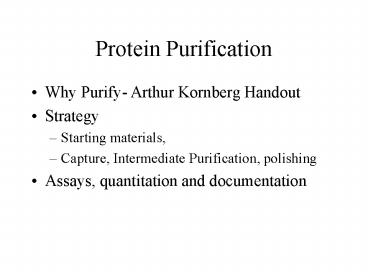Protein Purification - PowerPoint PPT Presentation
Title:
Protein Purification
Description:
Protein Purification Principles I (From APBiotech. Biochemistry 472/578 Resources) ... can be used for separation (size, charge, hydrophobicity, ligand specificity) ... – PowerPoint PPT presentation
Number of Views:187
Avg rating:3.0/5.0
Title: Protein Purification
1
Protein Purification
- Why Purify- Arthur Kornberg Handout
- Strategy
- Starting materials,
- Capture, Intermediate Purification, polishing
- Assays, quantitation and documentation
2
Protein Purification Principles I (From
APBiotechBiochemistry 472/578 Resources)
- Define objectives
- for purity, activity and quantity required of
final product to avoid over or under developing a
method - Define properties of target protein and critical
impurities - to simplify technique selection and optimisation
- Develop analytical assays
- for fast detection of protein activity/recovery
and to work efficiently - Remove damaging contaminants early
- for example, proteases
3
Protein Purification Principles II
- Use a different technique at each step
- to take advantage of sample characteristics which
can be used for separation (size, charge,
hydrophobicity, ligand specificity) - Minimize sample handling at every stage
- to avoid lengthy procedures which risk losing
activity/reducing recovery - Minimize use of additives
- additives may need to be removed in an extra
purification step or may interfere with activity
assays - Minimize number of steps - KEEP IT SIMPLE!
- extra steps reduce yield and increase time,
combine steps logically
4
Starting materials
- Natural source or artificial expression system
- Host for expression,
- Bacteria, yeast, plants, transgenic animals
- Abundance, contaminants
- Lysis and clarification procedures
- Native or denaturing conditions
- Subcellular fractionation
- Selective precipitation
- PEI or Streptomycin Sulfate for RNA and DNA
- Ammonium Sulfate for Proteins
5
Capture
- Quickly remove most damaging contaminants
- Concentrate, adsorption methods
- Ion Exchange most general
- Affinity chromatography can combine capture,
intermediate and polishing steps - This step should remove most unwanted contaminants
6
Intermediate purification
- Use a different technique
- Affinity chromatography, Hydrophobic interaction
chromatography - Starting conditions are specific for each
technique - Buffer must be compatible with adsorption
- Can change buffer by dialysis or desalting by GFC
- Adsorption techniques result in small volume
concentrated sample
7
Polishing
- Final removal of trace contaminants
- Often size exclusion chromatography
- Buffer exchange is a part of the process
- Sample volume always increases need to start with
a concentrated sample - Sample can be concentrated by
- Precipitation (selective or nonselective)
- Ultrafiltration (dialysis under pressure)
8
Assays, Quantitation and Documentation
- Assay enzyme activity at every step
- Contaminants at early stages can mask or inhibit
activity - Inactivation can occur at high temperatures,
because of proteolysis, oxidation, aggregation,
etc. - Assay total protein
- Run an SDS gel to visualize specific contaminants
- Specific activity is defined as units of
enzymatic activity per unit of total protein - - Yeild can be defined in terms of total protein
mass, and total enzyme units - Goal is a high yield and high specific activity.
9
Expt 5 Purification of Alkaline Phosphatase (AP)
- Periplasmic Protein in E. coli
- The space between the rigid peptidoglycan cell
wall and the osmotically sensitive plasma
membrane - Phosphate scavenger
- Liberates Pi from a variety of substrates
- Induced by phosphate starvation
- Used to remove terminal phosphates for selective
DNA ligation reactions - Heat stable, Zn enzyme
- Will be used for enzyme kinetics in Experiment 6.
10
Text Book Purification Overview (N B 175-195)
- 1. Lysozyme treatment to release periplasmic
proteins - Centrifugation to separate soluble AP from cells
- Dialysis to remove starting buffer (overnight)
- 2. Heat treatment to precipitate weaker proteins
- Centrifugation to separate soluble AP from
insoluble PPT - Ammonium sulfate to concentrate proteins/remove
non protein contaminants - Dialysis to remove ammonium sulfate (O/N)
- 3. Anion exchange (DEAE) chromatography
- Step elution with 0.125M Salt
- 4. SDS Page to quantify the proteins in each
fraction
11
Starting material
- E. coli cells starved for phosphate
- Sucrose shrinks the plasma membrane reduces
turgor pressure - Lysozyme cleave glycosidic linkages in cell wall
- DNAse reduces viscosity from inadvertantly lysed
cells - Left with AP, DNAse, Lysozyme, Sucrose other
periplasmic and cytoplasmic contaminants
12
Alternative strategy
- Osmotic shock used to liberate periplasmic
proteins - Many fewer proteins in periplasm than cytoplasm
- Sucrose draws water from cytoplasm, shrinks inner
membrane - EDTA permeabilizes cell wall
- Transfer to low osmotic strength buffer causes
the inner membrane to slam into the cell wall and
force out periplasmic proteins - Periplasmic proteins, no lysozyme, no DNAase, not
much sucrose - Periplasm rotococols in Biochemistry 472/578
Resources from Novagen
13
Assays
- Enzymatic assays
- PNPP is hydrolyzed to PNP and Pi
- Fixed time assay
- Mix enzyme and substrate, react for a fixed time,
s - top the reaction with a strong base,
- read the concentration of PNP at pHgt10
- Continuous assay
- Monitor PNP production directly in the spec at ph
8 - Bradford Assays for total protein
- SDS page for the distribution of proteins by
size.































